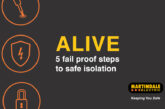
Damion Evans, owner of Ex Forces Electrician, shares his thoughts on some of the hidden dangers that can be associated with safe isolation when carrying out live testing of Ze, PFC and PFCC.
Before I start, let me first clarify that I fully support the practice of safe isolation, actively promote its use, and advocate for continuous improvement in its application.
This article contains my own thoughts and opinions, based on real-world experiences, and is designed to be thought-provoking and to create opportunities for further discussion around the subject area.
Hidden risks
It’s well established that safe isolation is an essential practice in the electrical industry, designed to protect engineers and others from potential hazards.
However, while safe isolation enhances safety in most situations, it presents its own unique challenges and risks during specific testing scenarios, such as live testing of Ze (earth loop impedance), PFC (prospective fault current), and PFCC (prospective fault current at consumer units), as well as when using locking-off kits.
We’ve all experienced it – locking off a distribution board (DB) or consumer unit (CU), only to find the locking-off kit swinging back and forth as you prepare to remove the cover. This seemingly minor issue can, however, have significant safety implications.
When the cover is removed, the conditions behind it are often unknown. Shrouds may not be securely in place, terminations could be loose, or other faults may exist. In these situations, a swinging lock-off device and padlock, especially on a three-phase (TPN) DB, can become hazardous.
In the worst-case scenario, the lock-off kit could come into contact with one or more phases, creating a short circuit. Similarly, the cover itself could become energised if it makes contact with a phase via the lock-off kit. To mitigate these risks, extreme caution must be exercised when removing the cover with a lock-off device in place.
My advice in this scenario is to remove the cover first, then install the locking-off device to minimise the risk of contact with live parts.
Safe isolation and testing Ze
When testing Ze or ZDB (distribution board impedance), it’s necessary to isolate the installation to eliminate parallel paths and ensure accurate test results. However, this isolation increases the risk of electric shock during the testing process, requiring engineers to take extra care.
The presence of locking-off kits during testing can introduce additional risks. Lock-off devices and padlocks can obstruct safe access to terminals on the incoming side of the main switch, increasing the likelihood of accidental short circuits.
Conducting a risk assessment
It is crucial to assess the risks associated with using locking-off kits during live testing. If you determine that the locking-off device presents a greater danger during testing, it is reasonable to temporarily remove it. You should then replace the lock-off device immediately after completing the tests.
When performing these tests, you are typically in direct control of the area, standing directly in front of the main switch. This makes it highly unlikely that someone would re-energise the installation without your knowledge. In such scenarios, isolation combined with other control measures – such as barriers – can provide adequate safety.
Industry guidance
Guidance Note 3 (GN3) includes an image of a lock-off device in use (pictured below).
An issue is the diagram in GN3 shows a single phase CU and it doesn’t create an obstacle to navigate around when testing the incoming terminals on the top, unlike on a 3 phase DB where it obstructs the incoming terminals at the bottom.
However, the accompanying text does not explicitly require a lock-off kit.
It states: “With the main switch open or with all circuits isolated.”
Similarly, BS 7671 defines isolation as: “A function intended to make dead for reasons of safety all or a discrete section of the electrical installation by separating the electrical installation, or section thereof, from every source of electrical energy.”
This definition highlights that isolation can be achieved without a lock-off kit in specific circumstances, provided the risks are managed appropriately.
A logical approach to safety
If your safety equipment – such as a lock-off device – creates additional hazards during testing, it is safer to temporarily remove it. You should, however, ensure the equipment is replaced immediately after completing the tests.
Safety must always take precedence, and a logical, risk-based approach is key to preventing incidents. By addressing these hidden dangers and carefully assessing the risks, we can continue to use safe isolation effectively while adapting our practices to maintain safety during live testing.
Let’s not forget, although safe isolation is a vitally important industry practice, it’s not always a one-size-fits-all solution!
Find more industry feature articles here










